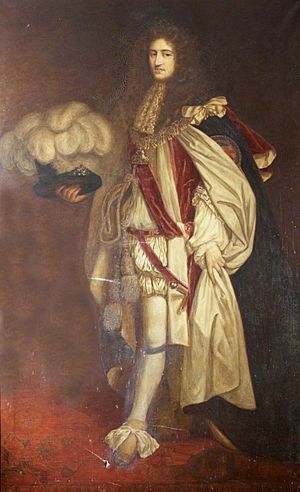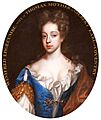Henry Somerset, 1st Duke of Beaufort facts for kids
Quick facts for kids
The Duke of Beaufort
|
|
|---|---|

Portrait by John Riley
|
|
| Born | 1629 |
| Died | 21 January 1700 (aged 70–71) |
| Noble family | House of Somerset |
| Spouse(s) | Mary Capell |
| Issue | 9, including Charles, Mary, Henrietta, and Anne |
| Father | Edward Somerset, 2nd Marquess of Worcester |
| Mother | Elizabeth Dormer |

Henry Somerset, 1st Duke of Beaufort (1629 – 21 January 1700) was an important Welsh politician. He was known as Lord Herbert for many years. He served in the House of Commons before becoming the 3rd Marquess of Worcester. Later, King Charles II made him the first Duke of Beaufort. He was a Knight of the Garter (KG) and a member of the Privy Council (PC).
Contents
Early Life and Beginnings
Henry Somerset was born in 1629 at Raglan Castle. From 1644, he was called Lord Herbert of Raglan. As a reward for his father's loyalty, he was promised marriage to Princess Elizabeth, King Charles I's youngest daughter. He left England during the First English Civil War but came back by 1650.
Becoming Lord Herbert
His father's lands had been taken away, but Henry was given money to live on. He changed his religious beliefs, which made him acceptable to Oliver Cromwell. He was then known simply as Mr. Herbert. In 1657, he had a "republican" marriage ceremony.
He became a Member of Parliament (MP) for Breconshire in 1654–5. After Cromwell's death, Henry joined those who wanted a "full and free parliament." This group wanted to bring back the royal family, the House of Stuart.
He was involved in a royalist plan in 1659 and was sent to the Tower of London. He was released later that year. In 1660, he was elected MP for Monmouthshire. He chose to represent Monmouthshire in the Convention Parliament. In 1661, he was re-elected for Monmouthshire and served until 1667.
Henry was one of twelve MPs who met Charles II in Breda, Netherlands, in 1660. After Charles became king, Henry received important jobs. He became the warden of the Forest of Dean and a lord lieutenant for several counties. He was allowed to keep his family's lands in Monmouthshire.
Lord Herbert stayed away from the royal court but had good relationships with important figures like the Hydes. In 1662, he helped tear down walls in Gloucester. The next year, he asked for a military group to stay at Chepstow. In 1663, he hosted the King and Queen at Badminton, Gloucestershire, an estate he had acquired. He also received a Master of Arts degree from Oxford University.
On 3 April 1667, he became the 3rd Marquess of Worcester after his father passed away.
As Marquess of Worcester
In April 1672, Worcester became the Lord President of the Council of Wales and the Marches. He also joined the Privy Council and became a Knight of the Garter.
During a time of political unrest called the Popish Plot, he had to be very careful. People close to him, like his brother-in-law, faced accusations. However, he managed to stay out of trouble himself.
He strongly supported the King's party. In 1680, he voted against a bill that would have stopped the King's brother from becoming king. Because of this, some members of Parliament asked the King to remove him from his advisors. However, King Charles saw his loyalty differently.
Becoming Duke of Beaufort
On 2 December 1682, the Marquess was given the new title of Duke of Beaufort. This title honored John Beaufort, an ancestor from three centuries earlier. Around this time, the Duke began to redesign his home at Badminton.
In 1683, Beaufort won a large sum of money in two lawsuits against people who had spread false information about him. In July 1684, he traveled through Wales as president of the region. He was welcomed with grand parties in many towns.
In 1685, he helped carry the Queen's crown at the coronation of King James II. He was also appointed a gentleman of the bedchamber and a colonel in the army.
When the Duke of Monmouth tried to rebel in 1685, Beaufort quickly took control of Bristol. He threatened to burn the city if any of Monmouth's supporters were let in. He also locked up people he thought might be disloyal. He gathered many soldiers to defend the city. Soon after, news came that Monmouth's rebellion had been defeated at the Battle of Sedgemoor.
On 24 September, King James II visited the Duke at Badminton and praised his loyalty. In October 1688, during the Glorious Revolution, Beaufort again took control of Bristol with his local soldiers. His men captured John Lovelace, 3rd Baron Lovelace, who was trying to join William of Orange. Beaufort prepared to defend Bristol, but he eventually had to surrender to a larger force. He supported the idea of a regency (a temporary government) rather than offering the crown to William of Orange.
On 14 December 1688, Beaufort met William at Windsor, but he was not warmly received. However, he took an oath of loyalty in March 1689. He even hosted William at Badminton in September 1690. By 1694, he was living quietly in Chelsea. In 1696, his house was searched because he was suspected of being involved in a plot against William, but nothing was found.
Later Years and Legacy
In March 1696, Beaufort was expected to sign a document of loyalty in the House of Lords, but he broke his shoulder. The document was sent to him, but he refused to sign it, though he said he hated any plots against William. By November 1697, he was on good terms with the court again. Sadly, he lost his son and heir, Charles, in a coach accident in Wales in July 1698.
Beaufort passed away at Badminton on 21 January 1700. He was buried in the Beaufort Chapel at St. George's Chapel, Windsor Castle. Later, his elaborate monument was moved to St Michael and All Angels Church, Badminton. This monument shows the Duke in his Garter robes, resting on a stone coffin. It has tall columns, carvings, and figures representing Justice and Truth.
A writer named Roger North described Beaufort's grand lifestyle. He had about 200 people working in his household. The Duke enjoyed hunting, planting trees, and building. He was known for being very strict, and his servants were always afraid of being fired. Even his neighbors were careful not to upset him.
Family Life
On 17 August 1657, Henry Somerset married Mary Capell. She was the daughter of Arthur Capell, 1st Baron Capell of Hadham and the widow of Henry Seymour, Lord Beauchamp. They had five sons and four daughters.
Their sons included:
- Henry, who died as a baby.
- Charles (1660–1698), who had a military and political career. He was supposed to become the next Duke, but he died before his father.
- Arthur (1671–1743), who married Mary Russell.
Their daughters included:
- Mary, who married James Butler, 2nd Duke of Ormonde.
- Henrietta, who married twice.
- Anne (1673–1763), who married Thomas Coventry, 2nd Earl of Coventry.
Because his son Charles died before him, the dukedom passed to Charles's son, Henry, after the 1st Duke's death.
Family Tree
| Family tree of the Earls of Leicester, and Earls of Lancaster and Dukes of Lancaster | |||||||||||||||||||||||||||||||||||||||||||||||||||||||||||||||||||||||||||||||||||||||||||||||||||||||||||||||||||||||||||||||||||||||||||||||||||||||||||||||||||||||||||||||||||||||||||||||||||||||||||||||||||||||||||||||||||||||||||||||||||||||||||||||||||||||||||||||||||||||||||||||||||||||||||||||||||||||||||||||||||||||||||||||||||||||||||||||||||||||||||||||||||||||||||||||||||||||||||||||||||||||||||||||||||||||||||||||||||||||||||||||||||||||||||||||||||||||||||||||||||||||||||||||||||||||||||||||||||||||||||||||||||||||||||||||||||||||||||||||||||||||||||||||||||||||||||||||||||||||||||||||||||||||||||||||||||||||||||||||||||||||||||||||||||||||||||||||||||||||||||||||||||||||||||||||||||||||||||||||||||||||||||||||||||||||||||||||||||||||||||||||||||||||||||||||||||||||||||||||||||||||||||||||||||||||||||||||||||||||||||||||||||||||||||||||||||||||||||||||||||||||||||||||||||||||||||||||||||||||||||||||||||||||||||||||||||||||||||||||||||||||||||||||||||||||||||||||||||||||
|---|---|---|---|---|---|---|---|---|---|---|---|---|---|---|---|---|---|---|---|---|---|---|---|---|---|---|---|---|---|---|---|---|---|---|---|---|---|---|---|---|---|---|---|---|---|---|---|---|---|---|---|---|---|---|---|---|---|---|---|---|---|---|---|---|---|---|---|---|---|---|---|---|---|---|---|---|---|---|---|---|---|---|---|---|---|---|---|---|---|---|---|---|---|---|---|---|---|---|---|---|---|---|---|---|---|---|---|---|---|---|---|---|---|---|---|---|---|---|---|---|---|---|---|---|---|---|---|---|---|---|---|---|---|---|---|---|---|---|---|---|---|---|---|---|---|---|---|---|---|---|---|---|---|---|---|---|---|---|---|---|---|---|---|---|---|---|---|---|---|---|---|---|---|---|---|---|---|---|---|---|---|---|---|---|---|---|---|---|---|---|---|---|---|---|---|---|---|---|---|---|---|---|---|---|---|---|---|---|---|---|---|---|---|---|---|---|---|---|---|---|---|---|---|---|---|---|---|---|---|---|---|---|---|---|---|---|---|---|---|---|---|---|---|---|---|---|---|---|---|---|---|---|---|---|---|---|---|---|---|---|---|---|---|---|---|---|---|---|---|---|---|---|---|---|---|---|---|---|---|---|---|---|---|---|---|---|---|---|---|---|---|---|---|---|---|---|---|---|---|---|---|---|---|---|---|---|---|---|---|---|---|---|---|---|---|---|---|---|---|---|---|---|---|---|---|---|---|---|---|---|---|---|---|---|---|---|---|---|---|---|---|---|---|---|---|---|---|---|---|---|---|---|---|---|---|---|---|---|---|---|---|---|---|---|---|---|---|---|---|---|---|---|---|---|---|---|---|---|---|---|---|---|---|---|---|---|---|---|---|---|---|---|---|---|---|---|---|---|---|---|---|---|---|---|---|---|---|---|---|---|---|---|---|---|---|---|---|---|---|---|---|---|---|---|---|---|---|---|---|---|---|---|---|---|---|---|---|---|---|---|---|---|---|---|---|---|---|---|---|---|---|---|---|---|---|---|---|---|---|---|---|---|---|---|---|---|---|---|---|---|---|---|---|---|---|---|---|---|---|---|---|---|---|---|---|---|---|---|---|---|---|---|---|---|---|---|---|---|---|---|---|---|---|---|---|---|---|---|---|---|---|---|---|---|---|---|---|---|---|---|---|---|---|---|---|---|---|---|---|---|---|---|---|---|---|---|---|---|---|---|---|---|---|---|---|---|---|---|---|---|---|---|---|---|---|---|---|---|---|---|---|---|---|---|---|---|---|---|---|---|---|---|---|---|---|---|---|---|---|---|---|---|---|---|---|---|---|---|---|---|---|---|---|---|---|---|---|---|---|---|---|---|---|---|---|---|---|---|---|---|---|---|---|---|---|---|---|---|---|---|---|---|---|---|---|---|---|---|---|---|---|---|---|---|---|---|---|---|---|---|---|---|---|---|---|---|---|---|---|---|---|---|---|---|---|---|---|---|---|---|---|---|---|---|---|---|---|---|---|---|---|---|---|---|---|---|---|---|---|---|---|---|---|---|---|---|---|---|---|---|---|---|---|---|---|---|---|---|---|---|---|---|---|---|---|---|---|---|---|---|---|---|---|---|---|---|---|---|---|---|---|---|---|---|---|---|---|---|---|---|---|---|---|---|---|---|---|---|---|---|---|---|---|---|---|---|---|---|---|---|---|---|---|---|---|---|---|---|---|---|---|---|---|---|---|---|---|---|---|---|---|---|---|---|---|---|---|---|---|---|---|---|---|---|---|---|---|---|---|---|---|---|---|---|---|---|---|---|---|---|---|---|---|---|---|---|---|---|---|---|---|---|---|---|---|---|---|---|---|---|---|---|---|---|---|---|---|---|---|---|---|---|---|---|---|---|---|---|---|---|---|---|---|---|---|---|---|---|---|---|---|---|---|---|---|---|---|---|---|---|---|---|---|---|---|---|---|---|---|---|---|---|---|---|---|---|---|---|---|---|---|---|---|---|---|---|---|---|---|---|---|---|---|---|---|---|---|---|---|---|---|---|---|---|---|---|---|---|---|---|---|---|---|---|---|---|---|---|---|---|---|---|---|---|---|---|---|---|---|---|---|---|---|---|---|---|---|---|---|---|---|---|---|---|---|---|---|---|---|---|---|---|---|---|---|---|---|---|---|---|---|---|---|---|---|---|---|---|---|---|---|---|---|---|---|---|---|---|---|---|---|---|---|---|---|---|---|---|---|---|---|---|---|---|---|---|---|---|---|
|
|||||||||||||||||||||||||||||||||||||||||||||||||||||||||||||||||||||||||||||||||||||||||||||||||||||||||||||||||||||||||||||||||||||||||||||||||||||||||||||||||||||||||||||||||||||||||||||||||||||||||||||||||||||||||||||||||||||||||||||||||||||||||||||||||||||||||||||||||||||||||||||||||||||||||||||||||||||||||||||||||||||||||||||||||||||||||||||||||||||||||||||||||||||||||||||||||||||||||||||||||||||||||||||||||||||||||||||||||||||||||||||||||||||||||||||||||||||||||||||||||||||||||||||||||||||||||||||||||||||||||||||||||||||||||||||||||||||||||||||||||||||||||||||||||||||||||||||||||||||||||||||||||||||||||||||||||||||||||||||||||||||||||||||||||||||||||||||||||||||||||||||||||||||||||||||||||||||||||||||||||||||||||||||||||||||||||||||||||||||||||||||||||||||||||||||||||||||||||||||||||||||||||||||||||||||||||||||||||||||||||||||||||||||||||||||||||||||||||||||||||||||||||||||||||||||||||||||||||||||||||||||||||||||||||||||||||||||||||||||||||||||||||||||||||||||||||||||||||||||||
Ancestry
| Ancestors of Henry Somerset, 1st Duke of Beaufort | ||||||||||||||||||||||||||||||||||||||||||||||||||||||||||||||||||||||||||||||||||||||||||||||||||||||||||||||||||||||||||||||||||||||||||||||||||||||||||||||||||||||||||||||||||||||||||||||||||||||||||||||||||||||||||||||||||||||||||||||||||||||||||||||||||||||||||||||||||||||||||||||||||||||||||||||||||||||||||||||||||||||||||||||||||||||||||||||||||||||||||||||||||||||||||||||||||||||||||||||||||||||||||||||||||||||||||||||||||||||||||||||||||||||||||||||||||||||||||||||||||||||||||||||||||||||||||||||||||||||||||||||||||||||||||||||||||||||||||||||||||||||||||||||||||||||||||||||||
|---|---|---|---|---|---|---|---|---|---|---|---|---|---|---|---|---|---|---|---|---|---|---|---|---|---|---|---|---|---|---|---|---|---|---|---|---|---|---|---|---|---|---|---|---|---|---|---|---|---|---|---|---|---|---|---|---|---|---|---|---|---|---|---|---|---|---|---|---|---|---|---|---|---|---|---|---|---|---|---|---|---|---|---|---|---|---|---|---|---|---|---|---|---|---|---|---|---|---|---|---|---|---|---|---|---|---|---|---|---|---|---|---|---|---|---|---|---|---|---|---|---|---|---|---|---|---|---|---|---|---|---|---|---|---|---|---|---|---|---|---|---|---|---|---|---|---|---|---|---|---|---|---|---|---|---|---|---|---|---|---|---|---|---|---|---|---|---|---|---|---|---|---|---|---|---|---|---|---|---|---|---|---|---|---|---|---|---|---|---|---|---|---|---|---|---|---|---|---|---|---|---|---|---|---|---|---|---|---|---|---|---|---|---|---|---|---|---|---|---|---|---|---|---|---|---|---|---|---|---|---|---|---|---|---|---|---|---|---|---|---|---|---|---|---|---|---|---|---|---|---|---|---|---|---|---|---|---|---|---|---|---|---|---|---|---|---|---|---|---|---|---|---|---|---|---|---|---|---|---|---|---|---|---|---|---|---|---|---|---|---|---|---|---|---|---|---|---|---|---|---|---|---|---|---|---|---|---|---|---|---|---|---|---|---|---|---|---|---|---|---|---|---|---|---|---|---|---|---|---|---|---|---|---|---|---|---|---|---|---|---|---|---|---|---|---|---|---|---|---|---|---|---|---|---|---|---|---|---|---|---|---|---|---|---|---|---|---|---|---|---|---|---|---|---|---|---|---|---|---|---|---|---|---|---|---|---|---|---|---|---|---|---|---|---|---|---|---|---|---|---|---|---|---|---|---|---|---|---|---|---|---|---|---|---|---|---|---|---|---|---|---|---|---|---|---|---|---|---|---|---|---|---|---|---|---|---|---|---|---|---|---|---|---|---|---|---|---|---|---|---|---|---|---|---|---|---|---|---|---|---|---|---|---|---|---|---|---|---|---|---|---|---|---|---|---|---|---|---|---|---|---|---|---|---|---|---|---|---|---|---|---|---|---|---|---|---|---|---|---|---|---|---|---|---|---|---|---|---|---|---|---|---|---|---|---|---|---|---|---|---|---|---|---|---|---|---|---|---|---|---|---|---|---|---|---|---|---|---|---|---|---|---|---|---|---|---|---|---|---|---|---|---|---|---|---|---|---|---|---|---|---|---|---|---|---|---|---|---|---|---|---|---|---|---|---|---|---|---|---|---|---|---|---|---|---|---|---|---|---|---|---|---|
|
||||||||||||||||||||||||||||||||||||||||||||||||||||||||||||||||||||||||||||||||||||||||||||||||||||||||||||||||||||||||||||||||||||||||||||||||||||||||||||||||||||||||||||||||||||||||||||||||||||||||||||||||||||||||||||||||||||||||||||||||||||||||||||||||||||||||||||||||||||||||||||||||||||||||||||||||||||||||||||||||||||||||||||||||||||||||||||||||||||||||||||||||||||||||||||||||||||||||||||||||||||||||||||||||||||||||||||||||||||||||||||||||||||||||||||||||||||||||||||||||||||||||||||||||||||||||||||||||||||||||||||||||||||||||||||||||||||||||||||||||||||||||||||||||||||||||||||||||
Images for kids


